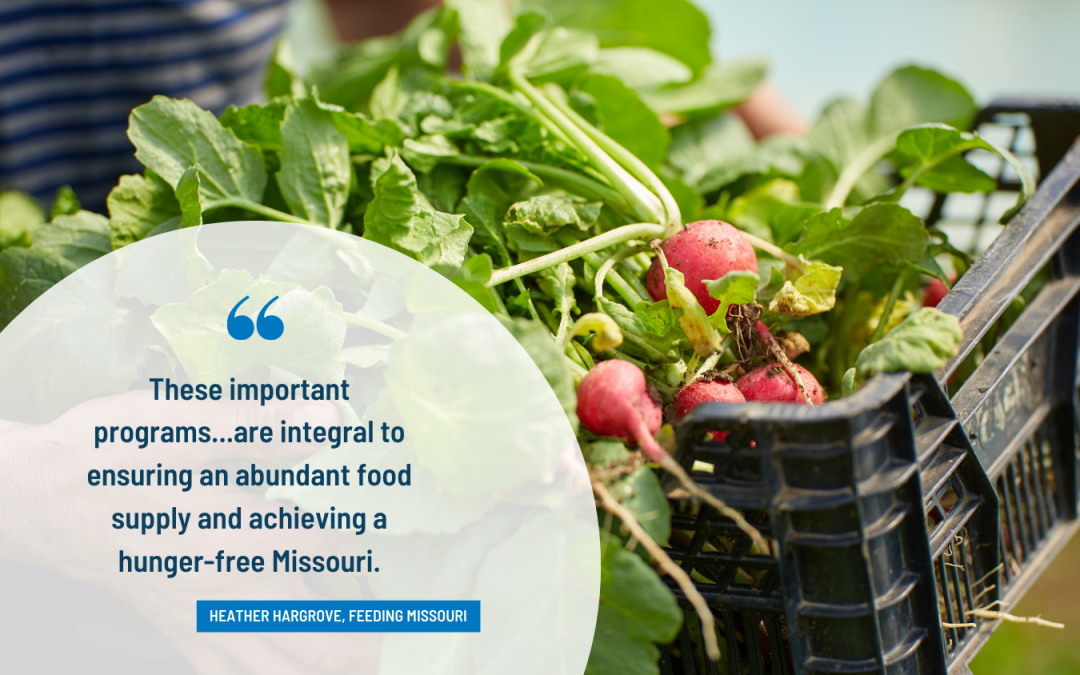Written by Heather Hargrove, Executive Director of Feeding Missouri Contributions by Bill McKelvey and Mary Hendrickson, University of Missouri
The Farm Bill is a comprehensive piece of legislation that affects farmers, the broader agriculture industry and consumers. Key programs of the Farm Bill deal with conservation, support payments for farmers and crop insurance. The largest share of spending — approximately 75% in the most recent Farm Bill — goes to programs that ensure healthy food access for low-income families across the country. Overall, the Farm Bill is an important pillar of our food and farming system in the United States and directly impacts local communities as well as Missouri’s number one industry: agriculture.
The Farm Bill has a long history. It was born in the 1930s under President Franklin Delano Roosevelt’s New Deal legislation. The focus was on keeping food prices fair for farmers and consumers, ensuring an adequate food supply and protecting natural resources. Although the bill has changed over the years, the primary goals remain the same. To keep up to date with changing farm and food needs, the Farm Bill expires every five years. Prior to its expiration, a new Farm Bill is reviewed and updated, going through a process where it is proposed, debated and passed by Congress. It is then signed into law by the President. Feeding Missouri advocates for and supports the missions of the six food banks in the state (Harvesters, The Food Bank for Central and Northeast Missouri, St. Louis Area Foodbank, Second Harvest Community Food Bank, Ozarks Food Harvest and Southeast Missouri Food Bank). As part of the nation-wide Feeding America network, these food banks work with over 1,200 faith-based and charitable agency partners, including food pantries, to distribute food in all 114 counties in Missouri and the City of St. Louis. University of Missouri research shows that Missourians who use food pantries face a host of challenges that are compounded by food insecurity. The 2021 Food Assistance & Hunger in the Heartland report, commissioned by Feeding Missouri and prepared by the University of Missouri Interdisciplinary Center for Food Security, shows the following for Missouri households who use food pantries:
- 70% experience food insecurity.
- 54% make $15,000 or less per year.
- 46% must choose between paying for food and utilities.
- 60% have a member with high blood pressure.
Rural areas are especially affected due to several challenges including lack of transportation, jobs that pay low wages and underemployment.
The food banks along with industry, non-profit and university partners work to support children, seniors, veterans, military families, working adults and others in putting food on the table. But as many of us have experienced, that has become more difficult with the increased cost of groceries. The food banks are also experiencing these challenges with the cost of transporting and storing food. In addition, food donations to the food banks have decreased. Thus, the programs supported through the Farm Bill are vital.
Farm Bill programs including The Emergency Food Assistance Program (TEFAP) and the Supplemental Nutrition Assistance Program (SNAP) are worth highlighting given their importance in alleviating hunger and supporting the agriculture sector and local economies.
TEFAP is a critical federal nutrition program that moves U.S.-grown food from farms to food banks to individuals and families facing hunger. It is an essential pipeline for food banks and a helping hand for Missourians navigating hunger. TEFAP food purchases provide access to more healthy foods, such as fruits and vegetables, eggs, meat, poultry, fish, nuts, milk, cheese and grain products for people facing hunger. In addition, these TEFAP purchases directly benefit farmers, food processors and others in the supply chain and serve an important role in supporting our state’s economy.
Alongside TEFAP, SNAP is the nation’s largest publicly funded food assistance program. Providing benefits that are only redeemable for food, this program boosts the grocery purchasing power of eligible families and generates a ripple effect in local communities and on Missouri’s economy. Moody’s Analytics estimates that every SNAP dollar spent locally generates $1.70 in economic growth. In fiscal year 2018, this equated to an additional $1.8 billion moving through local communities and the state. Additional Farm Bill funding supports nutrition education and health promotion programs for those who use SNAP, such as MU Extension’s Family Nutrition Education Program.
Combined, Farm Bill programs provide critical investments throughout the food and farming sector and reach into local communities and on to the dinner tables of Missouri families. These important programs, along with the network of public and private partners working to support both people and agriculture, are integral to ensuring an abundant food supply and achieving a hunger-free Missouri.

